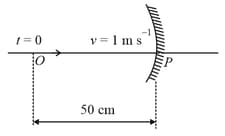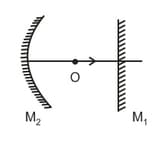EASY
Earn 100
What is linear magnification?
Important Questions on Reflection of Light
EASY
EASY
HARD
EASY
MEDIUM
A point object is moving uniformly towards the pole of a concave mirror of focal length along its axis as shown below. The speed of the object is . At , the distance of the object from the mirror is . The average velocity of the image formed by the mirror between time and is:

MEDIUM
| Column 1 | Column 2 | ||
| (A) | (a) | Convex mirror | |
| (B) | (b) | Concave mirror | |
| (C) | (c) | Real image | |
| (D) | (d) | Virtual image |
MEDIUM
| Object pin | Convex Lens | Convex Mirror | Image Pin |
| 22.2 cm | 32.2 cm | 45.8 cm | 71.2 cm |
HARD
(Graphs are drawn schematically and are not to scale)
EASY
EASY

EASY
MEDIUM
HARD
MEDIUM
Represent the union of two sets by Venn diagram for each of the following.
is a prime number between and
is an odd number between and
MEDIUM
EASY
HARD
MEDIUM
EASY
MEDIUM

